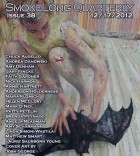Linda, I chose your story, first of all, because I loved the prose style, but I also think “The Abridged Biography of an American Sniper” draws the life of Jeremiah in a beautiful, compact way. I particularly like the way the wheat seems to become bread. If I were a director adapting this story for the screen, this transformation would be important to me. What is the significance of bread in this story of guns?
Chris, thank you for selecting this story and your kind words. When I first imagined Jeremiah, I knew he came from a family of wheat farmers—and hunters—a family who relied upon the land. Thus, self-sufficiency is one tie linking guns and wheat. Wheat is ground into flour to make bread, tortillas—the staff of life. Guns, of course, take life away, even though the taking of one life usually benefits that of the hunter. Fast-forward to Afghanistan, to an outpost where MREs constitute soldiers’ food. When a cook provides a real meal, bread becomes a rare commodity, almost sacred. It becomes a prayer, a communion. In the Afghani mountains, bread becomes a reflection of home, of American soil, of what might be lost.
I certainly felt this. Inside Jeremiah’s head at the end of the story, the reader is privy to the loss of his child and his wife, his imagined adultery with his brother’s wife. Regret? Is Jeremiah praying for forgiveness? Two of the later headings involve “criticism” and “self-criticism”. He, the sniper, even considers turning his gun on himself. Is this story entirely about a character named Jeremiah or is it also about “an American sniper”?
In researching the war in Afghanistan, I became interested in why young Americans would join the army during war. What I concluded was that for most soldiers, particularly infantrymen, the politics and morality surrounding war are inconsequential to their decision to fight. In today’s harsh economy, the armed services remains one of the largest employers left to young Americans, especially males with limited skills and/or education. Jeremiah is no different from many young men. He was a farmer and a hunter who, after losing so much, believes he has run out of options and joins the Army.
A sniper is a hunter, just one with a more specialized skill set. Both hunters and snipers are skilled shooters and, more importantly, skilled trekkers. And what is trekking but a form of seeking? Hunters and snipers seek their prey, and for both, the prey is food, be it in the form of a six-point buck or a direct-deposit paycheck. Of course, Jeremiah the American sniper seeks much more than food—he seeks purpose.
The form of the story has become quite popular. In the last year, I’ve read (and written) a considerable number of stories with internal headings. In my opinion you’ve masterfully used this popular structural technique to move the story along on rails. Can you talk a bit about your decision to use this structure?
The structure of this story was foisted upon me. I was struggling with ways to build several characters, including Jeremiah, and in one of my writing classes we read a prose poem by Michael Ondaatje (7 or 8 Things I Know About Her—A Stolen Biography), and I thought: I am going to steal this armature to flesh out my characters. Of the half-dozen sketches I wrote, this is the only one that evolved into something fluid enough to call a story. I find myself deviating from linear stories and moving into modular forms. The use of titles and subtitles add a richness and context that both power the story to its end and add resonance.
What other techniques do you use to create your characters?
Characters always come to me first when writing a story—not plot or theme, but some voice banging around my head who yelps loud enough to get out. I write many short stories and scenes around my characters before fleshing them out in longer stories and novels. My characters stick with me for a long time. Once, I kept a character’s journal for a year. I interview characters, a useful technique when stuck about actions or motivations. Flash-fiction serves as a great novel pre-writing tool; this story serves as the base for a 9000 word chapter, with segments (including the ending) that remain virtually unchanged.
What are you working on these days? Of course, I’ve heard you’re now the new senior fiction editor at JMWW. Congratulations. What are your own preferences in fiction as an editor?
Thank you! I am excited and humbled JMWW founding editor Jen Michalski trusts me in this new role. As an editor, I seek stories told with elegance and concision, stories that immerse me in place and character in profound, unique ways. I want to read submissions that make me miss my metro stop.
After three years focusing on short fictions, I have decided to dedicate my writing time to longer projects. I want to write a “proper” long story, one hovering at 5000 words or so. My current work-in-process is THE MINISTER’S WIFE, a novel of linked stories revolving around Maryam, a woman married to a Unitarian Universalist minister, who keeps the secrets of her husband’s congregants (and a few of her own, including Jeremiah). The book is about what happens when those secrets implode. I am shopping one completed novel, hoping to hook an agent. Last week I pulled out PURE, another novel marinating for over a year. I am excited and a little afraid to read it again.
I’ve read bits of THE MINISTER’S WIFE on Fictionaut. Excellent stories. Linda, thank you for “The Abridged Biography of an American Sniper.”
Thank you for your provocative questions!



 The core workshop of SmokeLong Fitness is all in writing, so you can take part from anywhere at anytime. We are excited about creating a supportive, consistent and structured environment for flash writers to work on their craft in a community. We are thrilled and proud to say that our workshop participants have won, placed, or been listed in every major flash competition. Community works.
The core workshop of SmokeLong Fitness is all in writing, so you can take part from anywhere at anytime. We are excited about creating a supportive, consistent and structured environment for flash writers to work on their craft in a community. We are thrilled and proud to say that our workshop participants have won, placed, or been listed in every major flash competition. Community works.